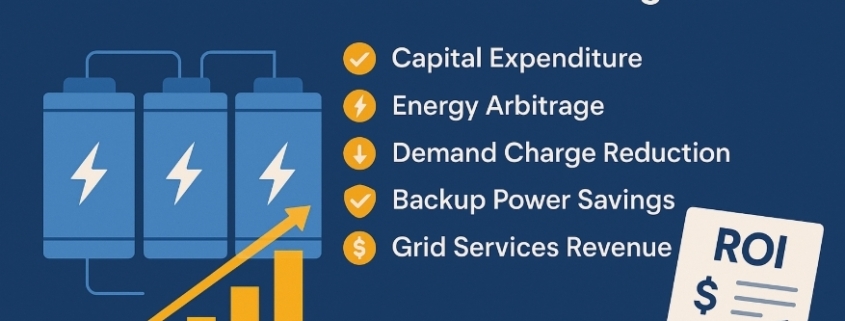The Economics of BESS: A Practical Guide to Calculating ROI
Battery Energy Storage Systems (BESS) are a smart solution for businesses that want to cut electricity costs, avoid peak charges, and get more from renewable energy. But before you invest, you must know the economics of BESS — and how to calculate your Return on Investment (ROI).
This guide explains the costs, savings, and key steps to help you decide if a BESS makes good financial sense for your business or large-scale project.
What Does a BESS Cost?
Understanding BESS costs is the first step in calculating ROI. Here’s what’s involved:
✔️ Capital Expenditure (CAPEX)
- Battery modules (like lithium-ion, sodium-ion, or flow batteries)
- Inverters or Power Conversion Systems (PCS)
- Energy Management Systems (EMS) and Battery Management Systems (BMS)
- Installation and grid connection fees
✔️ Operating Expenditure (OPEX)
- Regular inspections and maintenance
- Software updates and monitoring fees
- Insurance costs
- Replacements for battery modules or inverters over time
✔️ End-of-Life Costs
- Decommissioning and recycling fees
How BESS Saves or Earns You Money
The economics of BESS depend on how much you can save or earn over time.
⚡ Energy Arbitrage
Store energy when it’s cheap and use or sell it when prices spike.
⚡ Demand Charge Reduction
Cut peak demand charges by using stored energy during expensive hours.
⚡ Backup Power Savings
Avoid costly downtime during blackouts.
⚡ Grid Services Revenue
Some businesses earn money by helping stabilize the grid.
⚡ Renewable Energy Integration
Store surplus solar or wind energy instead of wasting it.
The Economics of BESS: Steps to Calculate Your BESS ROI
Here’s a clear, practical way to work out if BESS is worth it for you:
✅ 1. Define Your Project
- System size (kWh/kW)
- Expected charge/discharge cycles
- Local energy rates and demand charges
✅ 2. Estimate Total Costs
- Gather quotes for equipment, installation, and grid connection.
- Include yearly O&M costs for the entire lifespan.
✅ 3. Project Savings and Revenue
- Use your energy data to estimate savings from lower peak charges.
- Check if your area pays for grid services.
- Add any government incentives or tax credits.
✅ 4. Build a Simple Cash Flow
- Compare annual costs vs. annual savings/revenue.
- Run it for the entire expected lifespan (typically 10–20 years).
✅ 5. Calculate Payback Period and ROI
- Payback Period = Total Investment ÷ Annual Net Savings
- ROI = [(Total Net Savings – Total Cost) ÷ Total Cost] × 100%
Example:
If your BESS costs $400,000 and saves you $80,000 per year, your payback is 5 years. If the system lasts 15 years:
($80,000 × 15 – $400,000) ÷ $400,000 × 100% = 200% ROI.
The Economics of BESS: Tips for Better BESS ROI
✔️ Be realistic: Use conservative savings estimates.
✔️ Factor in battery aging: Storage capacity drops over time.
✔️ Know your local policies: Incentives vary by country or state.
✔️ Get expert help: A reliable consultant can build a strong financial model.
Final Thoughts
The economics of BESS can make a huge difference to your bottom line. Taking time to calculate your ROI properly helps you invest wisely and unlock long-term savings. For businesses serious about energy resilience and cost control, BESS can be a profitable piece of your energy strategy.
Frequently Asked Questions (FAQ) about The Economics of BESS
Q1: What’s a typical payback period for BESS?
A: Many businesses see a 5–7 year payback, but it depends on system size, local energy costs, and incentives.
Q2: Do BESS really last 15 years?
A: Good-quality BESS can last 10–20 years with proper maintenance, but performance slowly degrades.
Q3: Can I get tax credits for BESS?
A: Some regions offer grants, rebates, or tax credits. Check your local government’s energy programs.
Q4: Is BESS only for big companies?
A: Not at all! Small businesses, farms, and communities can benefit too — especially when paired with renewables.
Q5: Is BESS better suited for businesses with renewable energy?
A: Yes! Pairing BESS with solar or wind generation maximizes savings by storing excess energy for use during non-generating hours.
Q6: Are there any hidden costs in BESS projects?
A: Sometimes, grid interconnection fees, software subscriptions, or unexpected permitting costs can arise. Always add a contingency buffer.


